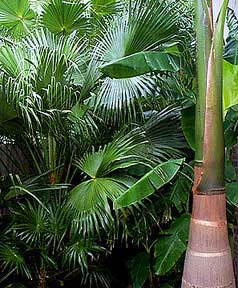Belonging to the Arecaceae family, palm plants are not genuine trees but woody perennials with a lone stem and expansive leaves. With over 2,600 varieties spread across 200-plus genera, they span a range of sizes, shapes, and habitats. Some palms can reach 200 feet (60 meters), while others comfortably sit in a pot. Some yield edible fruits like coconuts and dates, others are prized for their ornamental appeal. This article gives you a snapshot of 25 commonly found palm varieties and their distinctive traits.
- Pygmy Date Palm (Phoenix roebelenii): A modest palm reaching 10 feet (3 meters) and flaunting feather-like leaves that are 3 feet (1 meter) long. Native to Southeast Asia, it enjoys warm, humid conditions and produces sweet, juicy dates.
- Pindo Palm (Butia capitata): A medium palm that grows to 20 feet (6 meters) with 6-foot (2-meter) long blue-green, fan-shaped leaves. It bears yellow-orange fruits with a taste akin to pineapple. Indigenous to South America, it withstands cold and drought.
- Triangle Palm (Dypsis decaryi): Growing up to 40 feet (12 meters), this large palm with 10-foot (3-meter) long feather-like leaves sports a triangular-shaped base. While it doesn’t yield fruits, it flaunts attractive yellow flowers.
- Mediterranean Dwarf Palm (Chamaerops humilis): A compact palm that grows up to 15 feet (4.5 meters) with 2-foot (0.6-meter) long fan-shaped leaves. Native to Europe and North Africa, it braves cold and drought.
- Dwarf Majesty Palm (Ravenea hildebrandtii): A smaller palm reaching up to 12 feet (3.6 meters) and has 4-foot (1.2-meter) long feather-like leaves. While it doesn’t yield fruits, it sprouts fragrant white flowers.
- Christmas Palm (Adonidia merrillii): A medium palm growing up to 25 feet (7.5 meters) with feather-like leaves spanning 5 feet (1.5 meters) in length. The bright red fruits, though edible, are not particularly flavorful.
- Bottle Palm (Hyophorbe lagenicaulis): A smaller palm reaching 12 feet (3.6 meters) with 6-foot (1.8-meter) long feather-like leaves. Its trunk bears a distinct resemblance to a bottle. While it doesn’t yield fruits, it has eye-catching pink flowers.
- Canary Island Date Palm (Phoenix canariensis): Growing up to 60 feet (18 meters), this large palm yields orange, date-flavored fruits. Hardy to cold and drought, it’s often planted along streets and in parks.
- Chinese Fan Palm (Livistona chinensis): A medium palm reaching up to 30 feet (9 meters) with 5-foot (1.5-meter) long fan-shaped leaves. Native to China and Japan, it’s highly tolerant of cold and salt conditions.
- Coconut Palm (Cocos nucifera): A large palm soaring up to 100 feet (30 meters), it is renowned for its large, hard-shell fruits with white flesh. This palm variety is often grown for its fruits, oil, fiber, and timber.
- Date Palm (Phoenix dactylifera): Growing up to 75 feet (22 meters), this large palm is famous for its sweet, soft flesh fruits. This variety is often cultivated for its fruits, oil, and timber.
- European Fan Palm (Chamaerops humilis var. cerifera): A smaller palm reaching up to 15 feet (4.5 meters) with 2-foot (0.6-meter) long fan-shaped leaves. Resistant to cold and drought, it’s often grown as a hedge or in containers.
- King Palm (Archontophoenix alexandrae): Soaring up to 50 feet (15 meters), this large palm bears small, oval, purple edible fruits. Native to Australia, it prefers warm, moist conditions.
- Mazari Palm (Nannorrhops ritchiana): A small palm growing up to 10 feet (3 meters), it withstands cold, heat, and drought very well. It is often cultivated as an ornamental or indoor plant.
- Mexican Fan Palm (Washingtonia robusta): Growing up to 80 feet (24 meters), this large palm thrives in warm, sunny conditions and is commonly planted along streets or in large gardens.
- Needle Palm (Rhapidophyllum hystrix): A smaller palm growing up to 6 feet (1.8 meters), it is resistant to cold, heat, and drought, often cultivated as an ornamental or indoor plant.
- Parlor Palm (Chamaedorea elegans): Growing up to 6 feet (1.8 meters), it is native to Mexico and Central America and prefers moist and shady conditions. It is often grown as a houseplant.
- Queen Palm (Syagrus romanzoffiana): Reaching up to 50 feet (15 meters), this large palm sprouts 10-foot (3-meter) long pinnate leaves and bears small, yellow, edible fruits. Native to South America, it enjoys warm, sunny conditions.
- Royal Palm (Roystonea regia): A tall, impressive variety that can grow up to 80 feet (24 meters), featuring smooth, cylindrical trunks and 10-foot (3-meter) long pinnate leaves. It doesn’t produce edible fruits but is renowned for its ornamental value.
- Sabal Palm (Sabal palmetto): Growing up to 65 feet (20 meters), this medium palm exhibits 5-foot (1.5-meter) long fan-shaped leaves and small, black, edible fruits. It’s highly tolerant to salt and drought, making it a popular choice for coastal areas.
- Saw Palmetto (Serenoa repens): A small palm reaching up to 10 feet (3 meters) with 3-foot (0.9-meter) long fan-shaped leaves. Its berries are harvested for their medicinal properties, especially for treating prostate health issues.
- Senegal Date Palm (Phoenix reclinata): Growing up to 30 feet (9 meters), this medium palm produces sweet, date-like fruits. It has a clustering habit and can tolerate a range of soils and climates.
- Sago Palm (Cycas revoluta): Not a true palm but a cycad, it can grow up to 10 feet (3 meters) with 3-foot (0.9-meter) long palmate leaves. It’s grown more for its ornamental value than for its inedible fruits.
- Traveller’s Palm (Ravenala madagascariensis): Another non-palm, this large plant grows up to 40 feet (12 meters) with 10-foot (3-meter) long palmate leaves. The leaf bases can hold rainwater, which can be used as an emergency drinking source, hence the name.
- Windmill Palm (Trachycarpus fortunei): Growing up to 40 feet (12 meters), this medium palm showcases 2-foot (0.6-meter) long fan-shaped leaves. Renowned for its cold tolerance, it’s often grown in temperate regions.
Identifying palms by their leaves, trunks, and fruits
An easy way to distinguish palms is by looking at their leaves: palmate (fan-like) or pinnate (feather-like). Palmate leaves have leaflets radiating from a central point, while pinnate leaves have leaflets arranged along a central axis.
Additionally, their trunks can be smooth, rough, spiny, swollen, or branching. Some palms have fibrous or woody trunks, others may be hollow or filled with water.
The fruits of palms, round, oval, elongated, or clustered, also serve as identifiers. Some palm fruits are edible, while others are ornamental, coming in various colors.
Palms are incredible plants offering manifold benefits to humans and the environment: food, oil, fiber, timber, medicine, and aesthetic appeal. They provide shade, habitat, and oxygen for numerous creatures and plant life. As symbols of tropical beauty and exotic allure, they warrant our admiration and respect.




